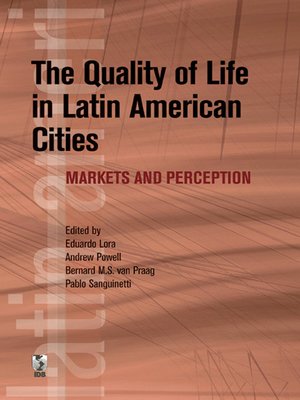The Quality of Life in Latin American Cities
ebook ∣ Markets and Perception · Latin American Development Forum
By Eduardo Lora

Sign up to save your library
With an OverDrive account, you can save your favorite libraries for at-a-glance information about availability. Find out more about OverDrive accounts.
Find this title in Libby, the library reading app by OverDrive.



Search for a digital library with this title
Title found at these libraries:
| Library Name | Distance |
|---|---|
| Loading... |
A growing number of cities around the world have established systems for monitoring the quality of urban life. Many of those systems combine objective information with subjective opinions and cover a wide variety of topics. This book assesses a method that takes advantage of both types of information and offers criteria to identify and rank the issues of potential importance for urban dwellers. This methodâwhich combines the so-called 'hedonic price' and 'life satisfaction' approaches to value public goodsâwas tested in pilot studies in six Latin American cities: Bogotá, Buenos Aires, Lima, MedellÃn, Montevideo, and San José of Costa Rica. It provides valuable insights to address key questions such as, ⢠Which urban problems have the greatest impact on peopleâs opinions of city management and the most widespread effects on their lives? ⢠Do gaps between perception and reality vary from one area of the city to another, especially between high- and low-income neighborhoods? ⢠Where can homebuilders most feasibly seek solutions to problems such as inadequate road infrastructure, a lack of recreational areas, or poor safety conditions? ⢠Which problems should government authorities address first, in light of their impact on the well-being of various groups of individuals and given private actorsâ abilities to respond? ⢠Which homeowners benefit the most from public infrastructure or services? ⢠When can or should property taxes be used to finance the provision of certain servicesâor the solution of certain problems? 'The Quality of Life in Latin American Cities: Markets and Perception' proposes a monitoring system that is easy to operate and that entails reasonable costs but also has a solid conceptual basis. Long the ideal of many scholars and practitioners, such a system may soon become a reality and have the potential to make a significant contribution to the decision-making processes in any city concerned with the well-being of its residents.







